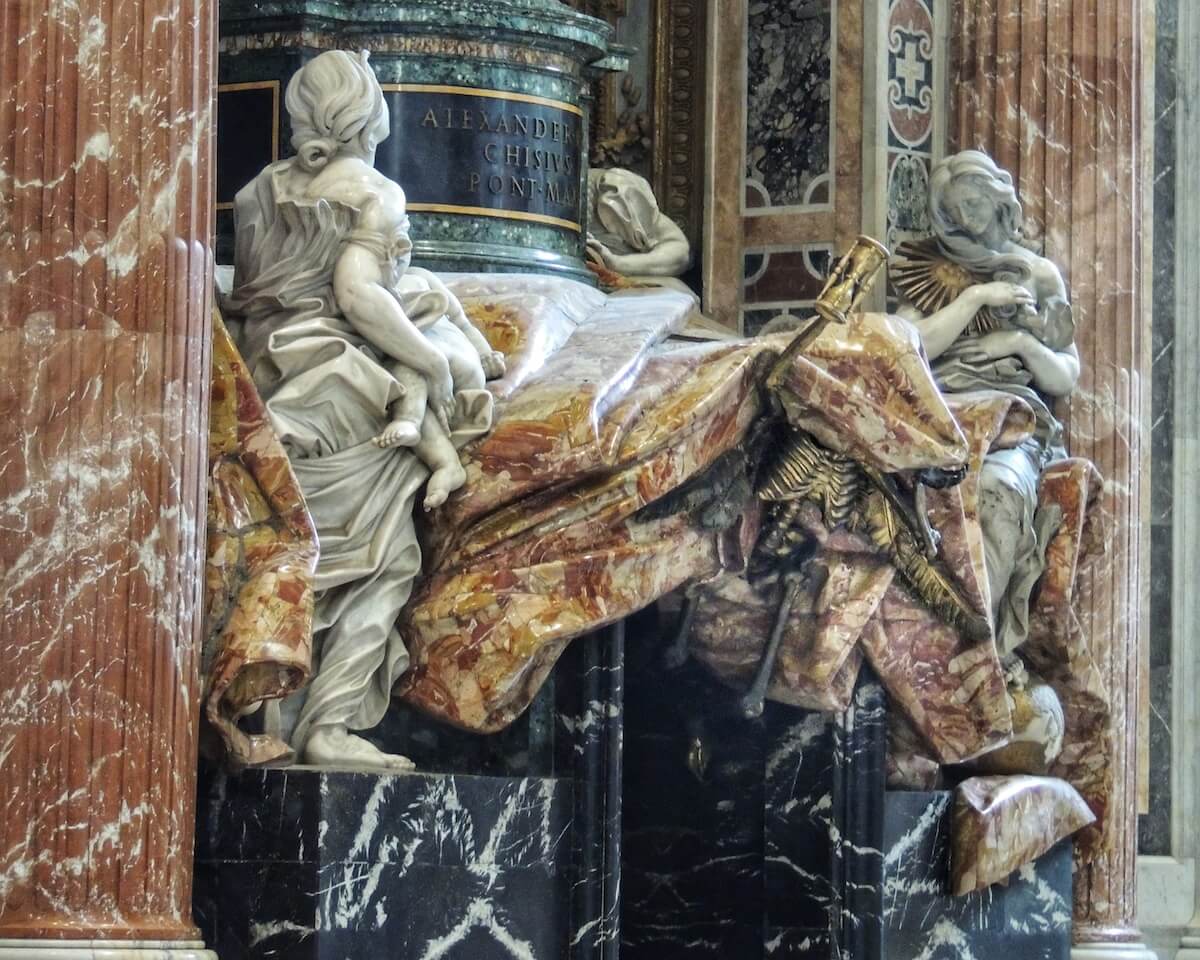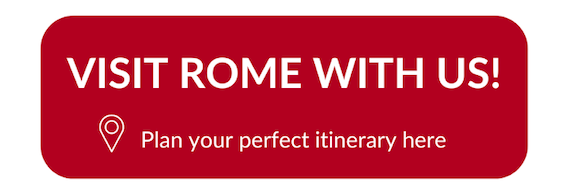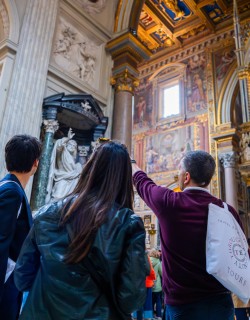You might not be as familiar with the name Gianlorenzo Bernini as you are with Michelangelo and Raphael, but no single figure has done more to shape the artistic and architectural landscape of Rome than the dashing sculptor known to contemporaries as ‘Il Cavaliere’.
Everywhere you go in Rome, from Piazza Navona to the Borghese Gallery, from the Vatican to the Palazzo Barberini, Capitoline Museums and beyond, you’ll encounter the works of this great genius of the Italian Baroque.
Born in 1598, Bernini was amazingly precocious, and was already wowing the most discerning patrons of Rome with his skills as a teenager. Over an incredibly long career spanning 9 decades, Bernini left behind a string of sculptural and architectural masterpieces in Rome that still rank amongst the greatest artworks ever made.
It’s arguably in the churches of Rome where the artist had his greatest triumphs, and to celebrate the upcoming Jubilee year of 2025 in Rome this week on our blog we’re taking a deep dive into the beautiful world of Bernini. Read on to discover 20 places where you can find his artworks in the Eternal City!
1. The Barcaccia Fountain

For Bernini, the art of sculpture was in his blood. Gianlorenzo’s father Pietro was a sculptor too, and though his achievements were eclipsed by his prodigy of a son, it’s largely to Pietro that we owe one of Rome’s loveliest fountains. This is the so-called Barcaccia, or Ugly Boat, at the foot of the Spanish Steps.
The fountain resembles a stricken ship: during disastrous floods that rocked Rome on Christmas day in 1598, high waters from the river River reportedly brought a boat as far as here before miraculously receding and sparing the city further devastation. When Pietro got the job of crafting the fountain, he brought his talented young son along to help - and so began the career of one of art history’s greatest titans.
-
Where to See it: Piazza di Spagna
2. The Early Masterpieces of the Borghese Gallery

When on the trail of Bernini in Rome, one of your first ports of call needs to be the fabulous Borghese Gallery. Housed in a spectacular Baroque villa built by the powerful Cardinal Scipione Borghese, the Gallery is home to a series of magnificent sculptures commissioned by Borghese from the young Bernini to decorate his villa.
Amongst them are the Apollo and Daphne, where a fleeing nymph transforms into a tree to escape the amorous clutches of the Olympian deity, and the brooding Pluto and Persephone, in which the lecherous god of the underworld drags the beautiful young princess into his dreadful underground realm. And that’s just the beginning.
Discover the complete works that Bernini created for Borghese in the Villa with our in-depth guide here: Bernini in the Villa Borghese.
-
Where to See Them: Villa Borghese
3. The Baldacchino

With the possible exception of Michelangelo, Bernini is the name most indelibly associated with the mother church of the Catholic world. The massive basilica was finally nearing completion when Bernini burst onto the art scene of 17th century Rome, and over the decades he spent as the city’s most illustrious sculptor he provided a series of magnificent works for St. Peter’s.
To mark the spot where St. Peter’s tomb lies, Bernini produced what is perhaps his most immediately recognizable work: a massive bronze monument located directly beneath Michelangelo’s dome. The enormous Baldacchino, as it’s known in Italian, is equal parts sculpture and architecture, a gravity-defying bronze canopy held up by massive spiraling bronze columns. Leaving the faithful in no doubt as to who was responsible for the deed, the commissioning Barberini Pope Urban VIII’s heraldic bees swarm all over the canopy.
For more on what you need to see in St. Peter’s check out our guide here: The Masterpieces of St. Peter's Basilica.
-
Where to See It: St. Peter’s Basilica
4. St. Longinus

While in St. Peter’s, look out for the Bernini-designed sculpture of St. Longinus installed on one of the huge piers of the crossing: the Roman soldier is captured at the moment of his conversion to Christianity, just after he had plunged his spear into the crucified Christ’s side to make sure of his death. Longinus’ conversion to the new religion earned him a one-way ticket to martyrdom, and St. Peter’s Basilica is reputedly in possession of part of the very lance with which he struck Christ - one of Christianity’s most precious relics, and an object that will be the subject of much devotion during the 2025 Jubilee in Rome.
-
Where to See It: St. Peter’s Basilica
5. Fountain of the Four Rivers

Piazza Navona is Rome’s greatest public space, a one-time ancient racetrack transformed into a thrilling piece of street theater. At its heart is Bernini’s spectacular Fountain of the Four Rivers. Commissioned by Pope Innocent IX as part of the Pamphilj family’s attempt to transform the piazza into an epic monument to themselves, Bernini’s jaw-dropping fountain features personifications of the four great world rivers known to the 17th-century world - the Nile, the Ganges, the Danube and the River Plate, holding up a soaring Egyptian obelisk. Discover the fascinating history and symbolism of the fountain here: Bernini's Fountain of the Four Rivers in Piazza Navona.
-
Where to See it: Piazza Navona
6. The Ecstasy of Saint Teresa

Suspended high in the air above the floor of the Cornaro Chapel in the church of Santa Maria della Vittoria, Saint Teresa levitates as if by magic. Floating on a marble cloud, the mystic saint is locked in an ambiguous embrace with a swooping angel poised to plunge a gold-tipped arrow into her flesh.
This was the Spanish mystic Teresa of Avila’s dream-like vision of the workings of divine love, simultaneously painful and ecstatic. Bernini set to work on this sculpture when he was at the height of his powers in the 1640s, commissioned by Federico Cornaro to provide a fitting monument to the mystically inclined Spanish nun who had just been elevated to the ranks of sainthood. Bernini’s work caused a sensation in Rome on its unveiling, and the great man himself modestly asserted that it was perhaps "the least bad work I have ever done.”
Read more about Teresa here: How Deep is your Love? The Painful Ecstasy of Bernini’s Saint Teresa.
-
Where to See It: Santa Maria della Vittoria
7. The Bridge of Angels
Ponte Sant’Angelo is one of only two river crossings in Rome to have survived largely intact from antiquity, and was completed during the reign of the Emperor Hadrian in 134 AD. It leads to imposing Castel Sant’Angelo, which began life as Hadrian’s own mausoleum before being repurposed variously as a fortress, prison and Papal palace over the centuries.
The bridge became the most important route to the Vatican for pilgrims in the Christian era. Posted all along the bridge, massive stone angels bearing the instruments of Christ's passion guard the route. The angels were designed by Bernini, and have watched over generations of pilgrims as they flooded across the Tiber to St. Peter’s Basilica.
-
Where to See it: Ponte Sant’Angelo
8. Monument to Maria Raggi
In Rome, generations of artists have made the impossible possible - but perhaps nobody broke the laws of physics more spectacularly than Bernini. In the basilica of Santa Maria Sopra Minerva, his memorial to the pious nun Maria Raggi stands as one of his most virtuoso flights of fancy, where hard black and yellow marble seems to flutter and twist in the air like the lightest drapery. This youthful sculpture by Bernini is not one of the master's best known works in the city, but it's definitely worth tracking down!
-
Where to See it: Santa Maria Sopra Minerva
9. Triton Fountain
Commissioned in 1642 by Pope Urban VIII of the Barberini family, this masterpiece showcases the Greek sea god Triton, emerging dramatically from a whirl of water, dolphins, and shells. With his conch, Triton sends a jet of water soaring into the sky, creating a striking visual centerpiece for the piazza.
This fountain marked Bernini’s debut in creating a freestanding public fountain and served as a vital water outlet for the restored Acqua Felice aqueduct, which Pope Urban revitalized to supply Rome’s expanding population. While the once-leafy aristocratic neighborhood surrounding the fountain has evolved into one of the city’s busiest intersections, Bernini’s Triton seems immune to the passage of time, and still sounds his triumphant horn.
-
Where to See It: Piazza Barberini
10. The Square Staircase of Palazzo Barberini
As the family home of one of Rome’s most important aristocratic families - popes and princes feature prominently in their family tree - it may come as no surprise that Palazzo Barberini is one of the city’s finest Baroque palaces. Everyone who was anyone in the early 17th-century had a hand in bringing the massive edifice to fruition, including, of course, the ever-present Bernini.
Bernini’s most lasting contribution to the design was a monumental square staircase that connected the main entrance to the piano nobile above. Today you can climb Bernini’s stairwell on a visit to Palazzo Barberini, now one of Italy’s finest art galleries. Inside, you can admire a number of papal busts by Bernini, too. Read more abot what you need to see in Palazzo Barberini here.
-
Where to See it: Palazzo Barberini
11. Saint Bibiana
The remains of the somewhat obscure saint Bibiana were discovered in the lead up to the Jubilee year of 1625, and the miraculous find led Pope Urban VIII to commission the young Bernini to restore the dilapidated church dedicated to the saint at the site. As part of the restorations, Bernini also carved a sculpture of the virgin martyr, which stands in the apse of the church to this day. Gaze fixed on the heavens above, Bibiana clutches the palm that symbolizes her martyrdom.
-
Where to See it: Santa Bibiana
12. The Chigi Chapel

The stunning Chigi Chapel in Santa Maria del Popolo is one of Rome’s most sumptuous funerary chapels. Created for Agostino Chigi, the fabulously wealthy businessman and banker who was also responsible for the Villa Farnesina across town, the chapel was originally designed by Raphael.
The great artist’s untimely death in 1520 meant that other hands also played a role in the chapel’s decorations, and Bernini provided the finishing touches over a century later when he provided sculptures of the Old Testament prophets Daniel and Habbakuk to complete the complex and fascinating ensemble.
-
Where to See it: Santa Maria del Popolo
13. The Fountain of the Bees

The Fountain of the Bees is much more diminutive, but no less lovely, than many of Bernini’s more monumental contributions to Rome’s built environment. Located on super-posh Via Vittorio Veneto, the fountain takes the form of a shell and, as you might have gathered, is ornamented with beautiful sculpted bees - which you might remember is the symbol of the powerful Barberini family who lived in the area. Completed in 1644, the little fountain had a practical function: it was designed to collect the returning water from the nearby Triton fountain in the center of Piazza Barberini, and doubled as a water trough for horses.
-
Where to See It: Via Veneto
14. Sant’Andrea al Quirinale
Whilst Bernini was most famous as a sculptor, he was also a fine architect. One of his best architectural creations is the beautiful little church of Sant'Andrea al Quirinale. The church features an innovative combination of painting, sculpture and architecture that seeks to take the viewer on a spiritual journey; on the altarpiece we can see the martyrdom of saint Andrew; as our eyes pan upwards the saint reappears in sculpted form ascending to heaven.
Bernini’s extraordinary oval dome (shaped this way to overcome the extremely narrow nature of the site), meanwhile, evokes the divine realm that forms the endpoint of Andrew’s spiritual journey. Bernini considered the church to be one of his most successful creations, and he reportedly spent hours inside contemplating his achievement.
-
Where to See it: Via del Quirinale
15. St. Peter’s Colonnade

Arguably Bernini’s most lasting contribution to the entire city of Rome is the magnificent colonnade he designed to frame the piazza leading to St. Peter’s Basilica. Here, two lines of massive columns swell outward, seemingly embracing the waves of pilgrims who come to pay their respects at the tomb of St. Peter.
At the center of the piazza stands a towering 40-meter tall Egyptian obelisk, brought to Rome in 37 BC and re-erected in front of the basilica in the 1580s. For centuries it was believed that the golden orb atop the ancient obelisk contained the ashes of Julius Caesar himself. When the globe was eventually opened, however, it was found to be empty.
-
Where to See It: Piazza San Pietro
16. The Fonseca Chapel
Designed in 1675 for Portuguese doctor Gabriela Fonseca, the Fonseca chapel in the lovely church of San Lorenzo in Lucina is a great example of the totalising approach Bernini took to his mature commissions, combining architecture, painting and sculpture to form a totally integrated, multifaceted work of 3-dimensional art.
Here Bernini hired the painter Giacinto Gimignani to copy Guido Reni's Annunciation altarpiece, and surrounded it with stucco angels and putti pointing the way to the chapel's beautiful diminutive dome. Bernini was responsible for the fantastic portrait bust of the good doctor himself, emerging from a pink marble niche.
-
Where to See it: San Lorenzo in Lucina
17. The Minerva Elephant

In a city of grandiose monuments, this is surely one of the most surprising. Proudly standing in front of the elegant Gothic church of Santa Maria sopra Minerva, an elephant stands high on a pedestal, his head caught in the act of swinging to the right, razor sharp tusks flanking a prodigiously long trunk snaking around the front of his body.
Exotic though they were, elephants were surprisingly a semi-regular feature in the Eternal City during the early-modern period. In 1514 the King of Portugal Manuel 1 gifted an elephant to Pope Leo X - the animal, christened Hanno, became the Pope's favorite pet, and was a regular feature in papal processions throughout the Medici pope's reign. And so when Pope Alexander VII decided to erect a monument centered around an Egyptian obelisk discovered in a Dominican convent garden in the 1660s, it’s not altogether surprising that this fashionable animal would play a central role.
-
Where to See it: Piazza della Minerva
18. Monument to the Blessed Ludovica Albertoni

One of the final works to be carved by Bernini also turned out to be one of his best. Ludovica Albertoni was renowned as one of early-modern Rome’s most pious women, devoting her life to helping the poor and other charitable works in the city. After her death in 1533, she was soon venerated locally in Trastevere and a campaign began to have her beatified.
Ludovica was finally recognised in 1671, at which point the aged Bernini was drafted in to carve a sculpture for her burial chapel in the church of San Francesco a Ripa. Bernini, who took on the job for free in order to obtain a pardon for his thuggish brother after an assault, came up with a vision of Ludovica in her death-throes, seemingly caught somewhere between agony and ecstasy as she clutches her hand to her breast.
-
Where to See it: San Francesco a Ripa
19. The Tomb of Pope Alexander VII

The fabulously complex tomb of Pope Alexander VII in St. Peter’s, carved by Bernini and his studio when the sculptor was in his 80s, almost reads like a mission statement of the ideals of Baroque sculpture. Here the venerable Chigi Pope kneels on a marble cushion at the top of the monument, lost in prayer. Representations of Charity, Justice, Prudence and Truth look up at the Pope. Truth rests her foot on a map of the world, signaling the Church’s dominion over the earth. Death himself arrives below, his face shrouded by an immense polychrome marble shroud and clutching an hourglass.
-
Where to See It: St. Peter’s Basilica
20. Salvator Mundi

With the Salvator Mundi at the catacombs church of Saint Sebastian Outside the Walls, we’ve finally come to the end of the line for Bernini. The seemingly immortal master was over 80 when he created this little bust of Christ in the guise of Salvator Mundi for his close friend Queen Christina of Sweden, who had lived in Rome for much of her adult life.
-
Where to See it: San Sebastiano fuori le mura
We hoped you enjoyed our guide to where to find the art of Bernini in Rome! Whether you are a sculpture obsessive or new to the world of art, Bernini’s dazzling Baroque visions will be sure to take your breath away when in the Eternal City. Through Eternity Tours offer a range of expert-guided itineraries that explore the works of Bernini in Rome, from Vatican tours to guided visits of the Borghese Gallery and walks through the fountains of the historic center. Check out our range of itineraries in Rome here!
MORE GREAT CONTENT FROM THE BLOG:
- Everything you Need to Know About Visiting Rome
- A Pilgrim and Tourists Guide to Jubilee 2025
- How to visit the Colosseum in 2024: Tickets, Hours, and More
- A History of the Jubilee in Rome
- Visiting the Vatican Museums and St. Peter's Basilica: The Complete Guide
- The Best Catacombs to Visit in Rome








